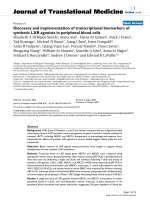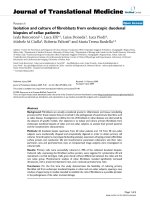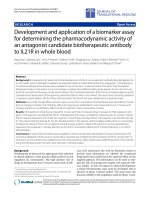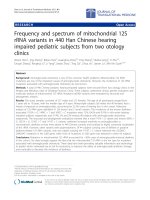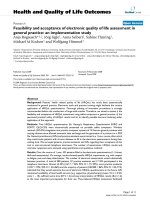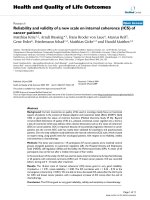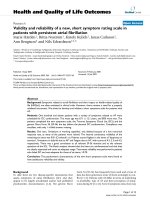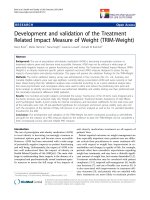báo cáo hóa học:" Effectiveness and Safety of Generic Fixed-Dose Combination of Tenofovir/Emtricitabine/Efavirenz in HIV-1-Infected Patients in Western India" doc
Bạn đang xem bản rút gọn của tài liệu. Xem và tải ngay bản đầy đủ của tài liệu tại đây (203.52 KB, 6 trang )
BioMed Central
Page 1 of 6
(page number not for citation purposes)
Journal of the International AIDS
Society
Open Access
Research article
Effectiveness and Safety of Generic Fixed-Dose Combination of
Tenofovir/Emtricitabine/Efavirenz in HIV-1-Infected Patients in
Western India
Sanjay Pujari*, Ameet Dravid, Nikhil Gupte, Kedar Joshix and Vivek Bele
Address: Institute of Infectious Diseases, Kumar Business Court, Pune, India
Email: Sanjay Pujari* -
* Corresponding author
Abstract
Objective: To assess effectiveness and safety of a generic fixed-dose combination of tenofovir
(TDF)/emtricitabine (FTC)/efavirenz (EFV) among HIV-1-infected patients in Western India.
Methods: Antiretroviral (ARV)-naive and experienced (thymidine analog nucleoside reverse
transcriptase inhibitor [tNRTI] replaced by TDF) patients were started on a regimen of 1 TDF/
FTC/EFV pill once a day. They were followed clinically on a periodic basis, and viral loads and CD4
counts were measured at 6 and 12 months. Creatinine clearance was calculated at baseline and at
6 months and/or as clinically indicated. Effectiveness was defined as not having to discontinue the
regimen due to failure or toxicity.
Results: One hundred forty-one patients who started TDF/FTC/EFV before 1 June 2007 were
eligible. Of these, 130 (92.2%) and 44 (31.2%) had 6- and 12-months follow-up, respectively. Thirty-
five percent of the patients were ARV-naive. Eleven patients discontinued treatment (4 for virologic
failure, 1 for grade 34 central nervous system disturbances, 4 for grade 34 renal toxicity, and 2 for
cost). Ninety-six percent of patients were virologically suppressed at 6 months. Frequency of TDF-
associated grade 34 renal toxicity was 2.8%; however, 3 of these patients had comorbid conditions
associated with renal dysfunction.
Conclusion: A fixed-dose combination of generic TDF/FTC/EFV is effective in ARV-naive and
experienced patients. Although frequency of severe renal toxicity was higher than has been
reported in the literature, it was safe in patients with no comorbid renal conditions.
Introduction
Antiretroviral therapy (ART) has significantly improved
clinical outcomes of HIV-infected individuals in the
developed and developing world.[1,2] Generic fixed-dose
thymidine analog nucleoside reverse transcriptase inhibi-
tor (tNRTI)-based combinations have been effective in
achieving virologic, immunologic, and clinical success in
the developing world.[3,4] However, reports are emerging
about the long-term complications associated with
tNRTIs, particularly those mediated by mitochondrial tox-
icity, including lipodystrophy, dyslipidemia, hyperlac-
tatemia, and peripheral neuropathy.[5] Due to the
concern of long-term toxicity associated with tNRTIs, par-
ticularly stavudine, ART guidelines around the world have
recommended using these drugs sparingly. Nucleos(t)ide
backbonesusing nonthymidine NRTIs (including tenofo-
vir [TDF] and abacavir) have been found to be effective
and safe over the long-term. In most of the developed
world, these drugs are the preferred option to begin ART
in naive HIV-infected individuals.[6]
Published: 20 August 2008
Journal of the International AIDS Society 2008, 10:196
This article is available from: />Journal of the International AIDS Society 2008, 10:196 />Page 2 of 6
(page number not for citation purposes)
Adherence has a major effect on treatment outcomes. Pill
burden and scheduling are 2 of the factors associated with
suboptimal adherence. A fixed-dose combination of TDF/
emtricitabine (FTC)/efavirenz (EFV) combines the benefit
of low pill burden (1 pill) with the simplest scheduling
(once daily). A generic combination of these drugs has
been available in India since September 2006 (Viraday;
Cipla; Mumbai). However, there are no data on the effec-
tiveness and safety of this combination. We assessed viro-
logic, immunologic, and clinical benefits and safety of
this combination in HIV-infected Indian patients.
Methods
Setting
This observational study was conducted at a private terti-
ary referral HIV care center in Pune, Western India.
Patients paid for their own drugs and laboratory investiga-
tions. The study was approved by an independent ethics
committee.
Patients
From September 2006 to June 2007, HIV-1 infected adult
patients initiating a fixed-dose combination of TDF/FTC/
EFV were consecutively recruited into the study. Only
patients who could afford the combination were started
on this regimen. Patients with a minimum of 6-months
follow-up were eligible for analysis. Patients were divided
into antiretroviral (ARV)-naive and antiretroviral-experi-
enced (substituting TDF for tNRTI because of toxicity,
convenience, or proactive change) groups. Before substi-
tution, virologic suppression (plasma viral load [PVL]
<400 copies/mL) was confirmed if the patient had been
on the previous regimen for more than 6 months.
Drugs
A generic combination of TDF/FTC/EFV was approved for
use in HIV-infected patients in India in September 2006.
The dose regimen was 1 pill once a day, and patients were
asked to take the pill preferably on an empty stomach at
night. Patients were assessed for readiness to begin treat-
ment before starting the regimen and were warned about
the adverse events (particularly central nervous system
[CNS] disturbances) associated with EFV use.
Assessments
Patients were followed up 1 month after treatment initia-
tion and quarterly thereafter. At each follow-up visit,
patients were assessed for complications, such as the
immune reconstitution inflammatory syndrome (IRIS)
and acute toxicity. Adherence was determined by self-
report and the patient's ability to keep the follow-up
appointments. CD4 counts (FACSCount; Becton Dickin-
son; Franklin Lakes, New Jersey) and PVLs (Cobas Ampli-
cor, Roche version 1.5) were determined every 6 months
(PVLs were determined only in patients who could afford
to pay for assays). Urinalysis and measurement of serum
creatinine levels were done at baseline and every 6
months or as clinically indicated. Creatinine clearance
(CrCl) was calculated using the Cockroft-Gault formula.
Virologic failure was defined as inability to achieve or
maintain an undetectable PVL (<400 copies/mL) at or
after 6 months of initiation of TDF/FTC/EFV, or rebound
of viral loads to above detectable limits (excluding blips)
after suppression.
Immunologic failure was defined as a decline >50% from
on-treatment peak CD4 values or a return to, or a fall
below, pretherapy baseline levels after 6 months of ther-
apy and persistent CD4 cells below 100/mm
3
after 6
months of treatment.
Clinical failure was defined as new or recurrent WHO
stage 4 HIV/AIDS 6 months after initiation of the regimen.
Virologic and immunologic failures were reconfirmed 2 to
4 weeks later by repeated determinations of PVL and CD4
counts, respectively.
IRIS was defined as occurrence of a new or paradoxical
worsening of an existing clinical condition (infectious or
noninfectious) within 6 months of initiation of ART.
Toxicity was graded according the system mentioned in
the WHO ART scale-up guidelines (modified from the
grading system of Division of AIDS, National Institute of
Allergic and Infectious diseases, USA). The regimen was
discontinued (substituted with nonoffending ARV drugs)
in cases of grade 34 toxicity.
Statistical Analysis
The proportion of patients who discontinued treatment
(because of failure or toxicity) was determined. Median
CD4 counts before and after initiation of the regimen
were determined at 6 and 12 months of follow-up. Uni-
variate analysis was used to determine the risk for grade
34 renal toxicity with age, gender, pretherapy CD4 counts
and CrCl, body mass index, background risk factors for
renal disease, duration of HIV infection since diagnosis,
WHO clinical stage at baseline, ART-naive or experienced,
and duration on TDF/FTC/EFV. Multivariate analysis was
not done because of the small number of grade 34 TDF
nephrotoxicity events. All analyses reported are for the"as-
treated" population.
Results
Patients and Follow-up
One hundred forty-one patients enrolled before 1 June
2007 were included in the final analysis. Of these, 49
(34.7%) patients were ARV-naive and 92 (65.3%) patients
were ARV-experienced (TDF substituted for reasons men-
tioned in Table 1). The total follow-up time for all
patients was 1285 months, 130 (92.2%) and 44 (31.2%)
Journal of the International AIDS Society 2008, 10:196 />Page 3 of 6
(page number not for citation purposes)
patients had at least 6- and 12-months follow-up, respec-
tively. Eight patients (5.6%) were lost to follow-up
(defined as not having been seen in the clinic for more
than 6 months after the last visit). Table 1 summarizes the
pretherapy characteristics of patients. The median dura-
tion of ARV exposure before initiation of TDF/FTC/EFV in
the ARV-experienced group was 12 months (range, 1 to 81
months).
Treatment Effectiveness
Median self-reported adherence was 96.6%. Four patients
needed to change ART because of ARV failure (Table 2). At
6 months, 96% of patients had PVL <400 copies/mL (data
on PVL available on 102 of 130 patients at 6 months, as
treated analysis). Table 2 summarizes the reasons for
treatment discontinuations in patients initiating TDF/
FTC/EFV.
The median change in CD4 counts at 6 and 12 months
among ARV-naive patients was +168 cells/microliter
(mcL) and +368 cells/mcL, respectively. The median
change in CD4 counts at 6 and 12 months among ARV-
experienced patients was +114 cells/mcL and +176 cells/
mcL, respectively. None of the patients receiving the regi-
men had immunologic or clinical failure.
Thirteen patients (11 ARV-naive and 2 ARV-experienced)
developed IRIS on TDF/FTC/EFV (8 cases of tuberculosis,
1 of cytomegalovirus vitreitis, 1 of hepatitis B virus, 1 of
Pneumocystis jiroveci pneumonia, 1 of herpes zoster, and 1
of cryptococcal meningitis). One patient with life-threat-
ening tuberculous IRIS temporarily discontinued the regi-
men.
Safety
The major toxicity associated with TDF/FTC/EFV was EFV-
induced CNS neuropsychiatric manifestations. Sixteen
patients had grade 12 self-limiting events, but 1 patient
had grade 4 CNS disturbances necessitating treatment dis-
continuation.
Four patients (2.8%) discontinued the regimen because of
grade 34 renal toxicity. The median duration to develop-
ment of nephrotoxicity was 2 months (1 to 12 months).
Three patients had a comorbid condition potentially asso-
ciated with renal disturbance (1 patient had a single kid-
ney, but normal CrCl at baseline; 1 patient had
hypertension; and chronic urinary tract infection, and 1
had dehydration). Of 17 patients with such conditions, 3
patients developed grade 34 renal toxicity. At 6 months,
median serum creatinine and CrCl were 1 mg/dL (range,
0.4 to 8.1) and 86.22 mL/minute (min) (range, 9.92 to
153.75), a change of 0.36 mL/min from baseline. Only
the above-mentioned 4 patients and 1 other patient (who
died of thrombotic thrombocytopenic purpura) had a
CrCl<50 mL/min on follow-up. On univariate analysis,
only CrCl at baseline was associated with grade 34 neph-
rotoxicity, with a relative risk ratio of 0.89 (95% CI, 0.83
to 0.96, P = .004).
Discussion
We have demonstrated the short-term effectiveness and
safety of a generic fixed-dose combination of TDF/FTC/
EFV. This 1-pill/once-a-day regimen was associated with
high levels of adherence and with minimal treatment-lim-
iting toxicity. Antiretroviral scale-up programs may con-
sider this regimen a better option than those provided
currently to enhance adherence, improve treatment suc-
cess, and limit tNRTItoxicity.
There are numerous advantages of using fixed-dose com-
binations for treatment of HIV infection, and they are
widely recommended to be used in both the developed
and developing world.[7] Fixed-dose combinations
reduce pill burden, thus improving adherence; are
cheaper than separate drugs; ensure that all the drugs in
the combination are taken; lead to fewer prescription
errors; and simplify program management. Disadvan-
tages, while few, include difficulty in adjusting the dose,
such as in cases of renal failure, and the need to discon-
tinue the entire formulation if 1 component of the com-
bination causes a treatment-limiting adverse event. An
additional concern with the once-daily regimen is the
potential for less "forgiveness" in the event of missed
doses.
A fixed-dose combination of TDF/FTC/EFV was found to
be bioequivalent to the individual formulations.[8]
Generic fixed-dose combinations have been found to be
of good quality, and many have been prequalified by
World Health Organization and United States Food and
Drug Administration for use in ART scale-up programs.
There are advantages in starting with a TDF-based regi-
men. In randomized, controlled trials, a combination of
TDF/FTC/EFV was found to be superior to zidovudine
(ZDV)/lamivudine (3TC)/EFV and d4T/3TC/EFV.[9,10]
Treatment discontinuation rates among the comparison
groups were higher in these studies than have been
reported by others. In the Gilead 934 trial,[9] CD4
improvements were greater in the TDF/FTC/EFV group
than in the ZDV/3TC/EFV group, possibly related to ZDV
bone-marrow suppression. Finally, a systematic overview
of clinical trials found that TDF/3TC or FTC combined
with EFV achieved better virologic responses than did
other nucleoside backbones.[11] In our study, we have
been able to show robust immunologic and virologic
responses, with 96% of patients (on as-treated analysis)
achieving undetectable viral loads at 6 months on ther-
apy.
Journal of the International AIDS Society 2008, 10:196 />Page 4 of 6
(page number not for citation purposes)
Table 1: Pretherapy Characteristics
Patient Characteristics ARV-Naive (n = 49) ARV-Experienced (n = 92)
Age, median (range), y 40 (2868) 39 (1874)
Sex
Male (%) 37 (75.5) 71 (77.1)
Female (%) 11 (24.5) 20 (22.9)
WHO stage before initiating current or past ART
Stage I 15 (30.6) 36 (39.1)
Stage II 5 (10.2) 10 (10.9)
Stage III 5 (10.2) 9 (9.9)
Stage IV 24 (49) 37 (40.1)
Duration of HIV infection since diagnosis months, median (range), y 18.5 (3161) 38 (2185)
Pretherapy body mass index, median (range) 21.365 (14.3633.2) 23.04 (12.335.16)
Current pretherapy CD4 count, median (range) 104.5 (6330) 309 (101259)
Reasons for substituting
Patients decision (mutually inclusive) 47
Stavudine (d4T)-related toxicity 5
Zidovudine (ZDV)-related toxicity 20
Dual toxicity (d4T and ZDV) 29
Convenience 34
Other (mostly co-infection with hepatitis B virus) 7
Co-infection with HBV
HBsAg-positive 3 (6.1) 4 (4.3)
HBsAg-negative 29 (59.2) 19 (20.7)
Unknown 17 (34.7) 69 (75)
Pretherapy renal function
Serum creatinine (mg/dL), median (range) 1 (0.51.9) 1 (0.41.8)
Creatinine clearance (mg/min), median (range) 71.9 (38.1145.5) 87.4 (32.5151.6)
ARV = antiretroviral agent; HBsAg = hepatitis B virus surface antigen; WHO = World Health Organization
Journal of the International AIDS Society 2008, 10:196 />Page 5 of 6
(page number not for citation purposes)
There have been reports that treatment-limiting toxicity
associated with currently recommended first-line regi-
mens in the developing world is common. Most toxicity is
associated with use of tNRTIs. A significant proportion of
patients develop morphologic and metabolic complica-
tions with use of d4T; these complications are also
reported with long-term use of ZDV at a lesser fre-
quency.[5] Many patients cannot tolerate d4T or ZDV; for
these patients, changing to TDF or abacavir is the only
option. Substituting one of these drugs has been shown to
sustain treatment effectiveness and mitigate some tNRTI
toxicity.[12] In India, abacavir is more expensive than
TDF, is not currently produced as a fixed-dose combina-
tion with 3TC, and is not available as a once-daily pill in
combination with EFV. Additionally, the prevalence of
HLA-B*5701 associated with the abacavir hypersensitivity
syndrome is unknown. For these reasons, it is better to
change to TDF/FTC/EFV for patients experiencing NRTI
toxicities or even to proactively prevent development of
some of the long-term toxicities. In our study, we demon-
strated continued virologic suppression and immunologic
benefit in patients who, for these reasons, changed to the
TDF/FTC/EFV regimen.
There has been a concern about renal toxicity associated
with TDF, although most studies have demonstrated low
frequencies.[13-15] In the Gilead 903 study,[10] no
patients discontinued TDF for renal toxicity through 288
weeks on treatment. TDF renal toxicity usually occurs
months after initiation of therapy (range, 5 to 26
months); however, it does occur within 8 weeks of initia-
tion of treatment in a significant subset of patients.[16,17]
Greater decreases in renal function have been described
when TDF is used along with a protease inhibitor-based
regimen than when it is used with a nonnucleoside RTI
(NNRTI).[18] In our patient population, the frequency of
grade 34 renal complications were a little higher than
those reported from other observational studies.[15]
However, most patients with renal complications had
comorbid renal conditions. All of these events occurred
within 6 months of initiation. Monitoring for TDF neph-
rotoxicity is recommended, especially in patients with
background renal disease and low CrCl at baseline. Meas-
uring serum creatinine levels is inexpensive (approxi-
mately US$1) and hence can be made widely available for
periodic monitoring of renal toxicity in ARV scale-up pro-
grams.
The frequency of adverse events associated with other
drugs in the regimen (FTC, EFV) was similar to that
described when these drugs were used in non-TDF-based
regimens.[10] CNS disturbances due to EFV were the most
common toxicity associated with this regimen. Treatment
was discontinued in 1 patient due to severe EFV-induced
CNS problems. We routinely warned the patients about
this toxicity and assured them that the symptoms were
self-limiting, and this may have contributed to underre-
porting. None of our patients reported hyperpigmenta-
tion associated with FTC.
Other advantages of initiating ART with a TDF/FTC/EFV is
effectiveness in treating concomitant chronic hepatitis B
virus infection, and a possible sequencing advantage even
if failure is identified late. The frequency of the K65R
resistance mutation associated with TDF is low.[19] Even
in the presence of K65R, tNRTIs would be effective com-
Table 2: Reasons for Stopping the FDC TDF/FTC/EFV Regimen
Reason 6 Months
(ART-naive), n = 45
6 Months
(ART experienced), n = 85
12 Months
(ART-naive), n = 8
12 Months
(ART-experienced), n = 36
Virologic failure 1 3 0 0
Immunologic
failure
0000
Clinical failure 0 0 0 0
CNS adverse
effects (grade 34)
1000
Renal toxicity
(grade 34)
1300
Cost
(change to
nevirapine)
0110
Death0001
Total3711
Journal of the International AIDS Society 2008, 10:196 />Page 6 of 6
(page number not for citation purposes)
ponents of second-line regimens.[20] Failing of tNRTIs
leads to accumulation of thymidine analog resistance
mutations that can compromise the entire NRTI class.
There are a few limitations in using this regimen as first-
line therapy in the developing world. TDF/FTC/EFV is the
most expensive of the NNRTI-based regimens, and the
generic version costs around US$1200 per year. All
patients in our study belonged to a higher socioeconomic
class and paid for their own treatment. However, it would
be reasonable to assume that this regimen would become
cheaper with time, particularly if demand increases.
Another limitation is the teratogenic effect associated with
EFV, which necessitates careful use or avoidance of this
regimen in women who are pregnant or who may
becomepregnant.
Although our study is observational and has limited fol-
low-up, it does demonstrate the effectiveness of generi-
cally manufactured fixed-dose combination of TDF/FTC/
EFV. Although grade 34 renal toxicity was common in the
study, the regimen was safe in patients who did not have
comorbid renal conditions. Further studies are needed to
confirm these observations. Finally, the patients accessing
care at our private clinic may differ from those who would
access free programs, which limits generalizability of the
conclusions. To our knowledge, this is the first report on
the use of a fixed-dose combination of TDF/FTC/EFV in
clinical practice, especially in the developing world. With
the numerous advantages of this regimen, it is time to
position it as first-line therapy for wider use in the devel-
oping world.
Authors and Disclosures
Sanjay Pujari, MD, AAHIVS, has disclosed no relevant
financial relationships.
Ameet Dravid, MD, has disclosed no relevant financial
relationships.
Nikhil Gupte, PhD, has disclosed no relevant financial
relationships.
Kedar Joshi, MD, has disclosed no relevant financial rela-
tionships.
Vivek Bele, MD, has disclosed no relevant financial rela-
tionships.
References
1. Palella FJ Jr, Delaney KM, Moorman AC, et al.: Declining morbidity
and mortality among patients with advanced human immu-
nodeficiency virus infection. HIV Outpatient Study Investiga-
tors. N Engl J Med 1998, 338:853-860. Abstract
2. Kumarasamy N, Solomon S, Chaguturu SK, et al.: The changing nat-
ural history of HIV disease: before and after the introduction
of generic antiretroviral therapy in southern India. Clin Infect
Dis 2005, 41:1525-1528. Abstract
3. Laurent C, Kouanfack C, Koulla-Shiro S, et al.: Effectiveness and
safety of a generic fixed-dose combination of nevirapine, sta-
vudine, and lamivudine in HIV-1-infected adults in Cam-
eroon: open-label multicentre trial. Lancet 2004, 364:29-34.
Abstract
4. Pujari S, Patel A, Eknath N, et al.: Effectiveness of generic fixed-
dose combinations of highly active antiretroviral therapy for
treatment of HIV infection in India. J Acquir Immune Defic Syndr
2004, 37:1566-1569. Abstract
5. Pujari SN, Dravid A, Naik E, et al.: Lipodystrophy and dyslipi-
demia among patients taking first-line, World Health
Organization-recommended highly active antiretroviral
therapy regimens in Western India. J Acquir Immune Defic Syndr
2005, 39:199-202. Abstract
6. Hammer SM, Saag MS, Schechter M, et al.: Treatment for adult
HIV infection: 2006 recommendations of the International
AIDS Society-USA panel. JAMA 2006, 296:827-843. Abstract
7. World Health Organization: Antiretroviral therapy for HIV
infection in adults and adolescents in resource limited set-
tings: towards universal access. [www.who.int
]. Accessed Octo-
ber 17, 2007
8. Mathaiss AA, Hinkle J, Menning M, et al.: Bioequivalence of efa-
virenz/emtricitabine/tenofovir disoproxil fumarate single
tablet regimen. J Acquir Immune Defic Syndr 2007 in press.
9. Pozniak AL, Gallant JE, DeJesus E, et al.: Tenofovir disoproxil
fumarate, emtricitabine, and efavirenz versus fixed-dose
zidovudine/lamivudine and efavirenz in antiretroviral-naive
patients: virologic, immunologic, and morphologic changesa
96-week analysis. J Acquir Immune Defic Syndr 2006, 43:535-540.
Abstract
10. Gallant JE, Staszewski S, Pozniak A, et al.: Efficacy and safety of ten-
ofovir DF vs stavudine in combination therapy in antiretro-
viral naive patients: a 3 year randomized trial. JAMA 2004,
292:191-201. Abstract
11. Bartlett JA, Chen SS, Quinn JB: Comparative efficacy of nucleo-
side/nucleotide reverse transcriptase inhibitors in combina-
tion with efavirenz: results of a systematic overvirew. HIV Clin
Trials 2007, 8:221-226. Abstract
12. Milinkovic A, Martinez E, Lopez S, et al.: The impact of reducing
stavudine dose versus switching to tenofovir on plasma lip-
ids, body composition and mitochondrial function in HIV-
infected patients. Antivir Ther 2007, 12:407-415. Abstract
13. Cassetti I, Madruga JV, Suleiman JM, et al.: The safety and efficacy
of tenofovir DF in combination with lamivudine and efa-
virenz through 6 years in antiretroviral-naive HIV-1-infected
patients. HIV Clin Trials 2007, 8:164-172. Abstract
14. Gallant JE, Parish MA, Keruly JC, et al.: Changes in renal function
associated with tenofovir disoproxil fumarate treatment,
compared with nucleoside reverse-transcriptase inhibitor
treatment. Clin Infect Dis 2005, 40:1194-1198. Abstract
15. Nelson MR, Katalama C, Montaner JS, et al.: The safety of tenofovir
disoproxil fumarate for the treatment of HIV infection in
adults: the first 4 years. AIDS 2007, 21:
1273-1281. Abstract
16. Patel SM, Zembower TR, Pallela F, et al.: Early onset of tenofovir
induced renal failure: Case report and review of literature.
Scientific World Journal 2007, 7:1140-1148. Abstract
17. Malik A, Abraham P, Malin N: Acute renal failure and Fanconi
syndrome in an AIDS patient on tenofovir treatment-case
report and review of literature. J Infect 2005, 51:E61-E65.
Abstract
18. Goicoechea M, Liu S, Best B, et al.: Greater tenofovir associated
renal dysfunction decline with protease inhibitor based ver-
sus non-nucleoside reverse transcriptase inhibitor based
therapy. J Infect Dis 2008, 197:102-108.
19. Margot NA, Lu B, Cheng A, et al.: Resistance development over
144 weeks in treatment-naive patients receiving tenofovir
disoproxil fumarate or stavudine with lamivudine and efa-
virenz in Study 903. HIV Med 2006, 7:442-450. Abstract
20. Gallant JE: Drug resistance after failure of initial antiretroviral
therapy in resource limited countries. Clin Infect Dis 2007,
44:453-455. Abstract
